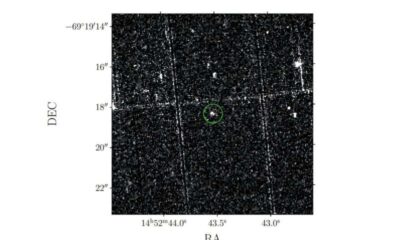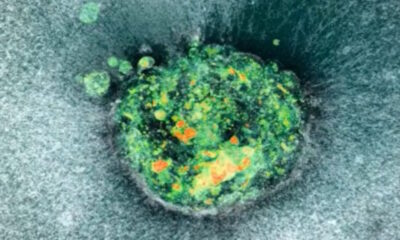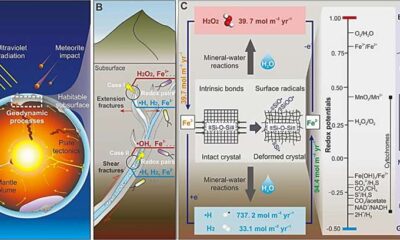Science
Johns Hopkins Engineers Quantum Sensors for Early Disease Detection

Engineers at Johns Hopkins University have developed an innovative class of quantum sensors capable of detecting extremely faint molecular vibrations. This breakthrough, led by Ishan Barman, could significantly enhance early disease diagnosis, as well as improve industrial monitoring and environmental surveillance. The findings were published in the scientific journal Science Advances on August 26, 2025.
The advanced quantum sensors utilize a new approach to detect molecular vibrations, which can provide chemical “fingerprints” indicative of various diseases. By identifying these unique movements of atoms within molecules, the sensors could lead to faster and more accurate detection of disease biomarkers found in blood, saliva, or urine. This capability is particularly crucial for diagnosing conditions ranging from infections to metabolic disorders and cancer.
Enhancing Detection Methods
Traditional techniques, such as infrared or Raman spectroscopy, face challenges due to the faintness of signals that are often lost in background noise. Barman, who holds positions at the Sidney Kimmel Comprehensive Cancer Center and the Department of Radiology and Radiological Science at the Johns Hopkins School of Medicine, emphasized the need for a more radical solution. “We were trying to overcome a long-standing challenge in molecular sensing: how do you make optical detection of molecules more sensitive, more robust, and more adaptable to real-world conditions?”
To achieve this, the research team employed highly reflective gold mirrors to create an optical cavity, which enhances the interaction between light and enclosed molecules. This technique leads to the formation of new quantum states known as “vibro-polaritons,” enabling the sensors to detect molecular vibrations effectively under ambient conditions without requiring extreme environments typically necessary for preserving fragile quantum states.
A Broader Impact on Science and Industry
The implications of this research extend beyond disease detection. In pharmaceutical manufacturing, quantum sensors could facilitate real-time monitoring of complex chemical reactions, ensuring product safety and consistency. In environmental science, they hold the potential for trace-level detection of pollutants or hazardous compounds with unprecedented reliability.
Lead author Peng Zheng, an associate research scientist in mechanical engineering at Johns Hopkins, noted that this study marks a significant transition from concept to practical application. “Rather than passively detecting molecules, we can now engineer the quantum environment around them to enhance their optical fingerprints,” Zheng explained.
This advancement represents a crucial step forward in the field of quantum sensing, with future applications likely to include compact, microchip-scale devices. Barman envisions a future where these technological advancements are integrated into portable, point-of-care tools and artificial intelligence-powered diagnostic systems.
The research highlights the transformative potential of quantum sensing technologies in the medical field, biomanufacturing, and environmental protection. “The future of quantum sensing isn’t stuck in the lab — it’s poised to make a real-world impact,” Barman concluded.
-

 Entertainment3 weeks ago
Entertainment3 weeks agoKim Cattrall Posts Cryptic Message After HBO’s Sequel Cancellation
-

 Entertainment3 weeks ago
Entertainment3 weeks agoAldi Launches Cozy Autumn Fragrance Range Ahead of Halloween
-

 Entertainment1 month ago
Entertainment1 month agoSpeculation Surrounds Home and Away as Cast Departures Mount
-

 Entertainment3 weeks ago
Entertainment3 weeks agoMarkiplier Addresses AI Controversy During Livestream Response
-

 Entertainment3 weeks ago
Entertainment3 weeks agoLas Culturistas Awards Shine with Iconic Moments and Star Power
-

 Science4 weeks ago
Science4 weeks agoAstronomers Unveil New Long-Period Radio Transient ASKAP J1448−6856
-

 Lifestyle4 weeks ago
Lifestyle4 weeks agoTesco Slashes Prices on Viral Dresses in Summer Clearance Sale
-

 Politics1 month ago
Politics1 month agoPlane Crash at Southend Airport Claims Four Lives After Takeoff
-

 Health3 weeks ago
Health3 weeks agoWakefield’s Top 13 GP Practices Revealed in 2025 Patient Survey
-

 Sports4 weeks ago
Sports4 weeks agoCommunity Pays Tribute as Footballer Aaron Moffett Dies at 38
-

 Top Stories1 month ago
Top Stories1 month agoAustralian Man Arrested for Alleged Damage to Stone of Destiny
-

 Entertainment4 weeks ago
Entertainment4 weeks agoEmmerdale Characters Face Danger as Stabbing Shakes Village

















